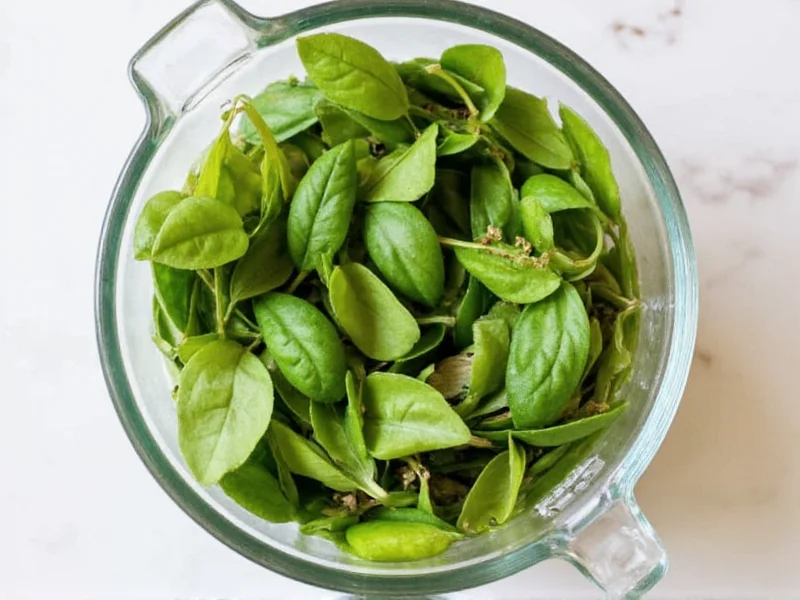When converting fresh basil to dried in recipes, understanding the precise measurement ratio is essential for maintaining balanced flavors. The standard culinary conversion guideline states that dried herbs are generally three times more concentrated than fresh herbs due to the removal of water content during the drying process. This means you need less dried basil to achieve a similar flavor intensity as fresh.
Understanding the Fresh to Dried Herb Conversion Ratio
The 3:1 ratio between fresh and dried herbs isn't arbitrary—it's based on the physical transformation that occurs when herbs dry. Fresh basil contains approximately 90% water, which evaporates during the drying process. What remains is a more concentrated form of the essential oils and flavor compounds that give basil its distinctive taste.
When substituting dried basil for fresh in recipes, particularly when working with 1/2 cup of fresh basil, you're essentially working with the concentrated essence of that larger volume. Professional chefs and food scientists confirm that dried herbs typically deliver 2-3 times the flavor punch of fresh herbs by volume, which is why the conversion isn't a simple 1:1 replacement.
Complete Fresh Basil to Dried Basil Conversion Chart
| Fresh Basil | Dried Basil | Best Usage Context |
|---|---|---|
| 1 tablespoon | 1 teaspoon | Finishing touches, garnishes|
| 1/4 cup | 1 tablespoon | Sauces, dressings, marinades|
| 1/2 cup | 2-3 tablespoons | Main conversion for most recipes|
| 1 cup | 1/3 cup | Long-cooking dishes, stews|
| 2 cups | 2/3 cup | Large batch cooking, preserving
Practical Application in Cooking
When substituting dried basil for 1/2 cup of fresh basil in your recipes, consider these practical tips for optimal results:
- Add dried herbs earlier: Unlike fresh basil which is often added at the end of cooking, dried basil benefits from being added earlier to allow time for rehydration and flavor release
- Adjust to taste: Start with 2 tablespoons of dried basil when replacing 1/2 cup fresh, then taste and adjust as needed—some dried basil varieties are more potent than others
- Consider the dish type: For delicate dishes like fresh tomato salads, you might want to use slightly less dried basil (closer to 2 tablespoons), while heartier dishes like tomato sauces can handle the full 3 tablespoons
- Reconstitute when possible: For best results, mix dried basil with a small amount of warm water or olive oil before adding to your recipe to help release flavors
Why the Range in Conversion Measurements?
You might notice that conversion charts often show a range (2-3 tablespoons) rather than a single precise measurement when converting 1/2 cup fresh basil to dried. This variation exists for several legitimate reasons:
- Drying method differences: Sun-dried, oven-dried, and commercially dehydrated basil retain different concentrations of essential oils
- Storage conditions: Dried basil loses potency over time—properly stored in airtight containers away from light, it maintains strength for 1-2 years
- Harvest timing: Basil picked at different growth stages contains varying concentrations of flavor compounds
- Measurement technique: How tightly you pack dried basil into a measuring spoon affects the actual quantity used
When Precision Matters: Baking vs. Cooking
The importance of accurate fresh basil to dried conversion varies depending on your culinary application. In baking applications where chemical reactions are critical, such as herb-infused breads or focaccia, precise measurements following the 1/2 cup fresh to 2-3 tablespoons dried ratio are essential. A small variation can significantly impact flavor balance.
For most cooking applications, however, experienced cooks treat these conversions as starting points rather than absolute rules. When substituting dried basil for 1/2 cup fresh in tomato-based sauces, soups, or stews, the margin for adjustment is greater. The key is to add dried herbs gradually, allowing time for flavors to develop between additions.
Quality Considerations for Dried Basil
Not all dried basil delivers the same flavor intensity, which affects how much you need when replacing 1/2 cup of fresh. High-quality dried basil should:
- Have a vibrant green color (not brown or yellow)
- Crush easily between fingers
- Release a strong, sweet aroma when rubbed
- Have been stored properly in an airtight container away from light
Lower quality dried basil that has been improperly stored or is past its prime may require using closer to 3 tablespoons when substituting for 1/2 cup fresh basil to achieve the desired flavor profile.
Expert Tips for Perfect Herb Substitutions
Professional chefs recommend these additional considerations when converting fresh basil measurements to dried:
- Consider the recipe's liquid content: In dishes with high liquid content like soups, you may need to increase the dried basil slightly as flavors disperse more
- Account for cooking time: Longer cooking times allow more flavor extraction from dried herbs, so you might use less if simmering for hours
- Combine with complementary herbs: When substituting dried basil for fresh, adding a pinch of oregano can help recreate the complex flavor profile of fresh basil
- Store dried basil properly: Keep in a cool, dark place in an airtight container to maintain potency for accurate future conversions











 浙公网安备
33010002000092号
浙公网安备
33010002000092号 浙B2-20120091-4
浙B2-20120091-4